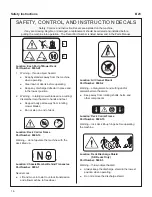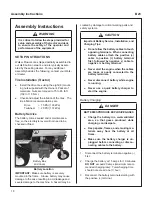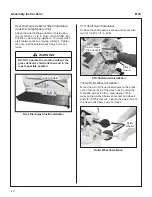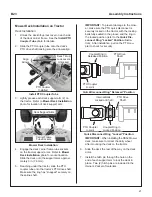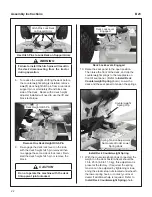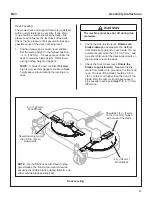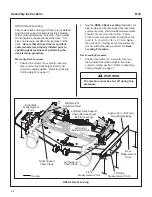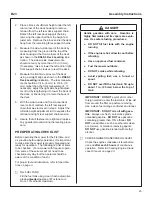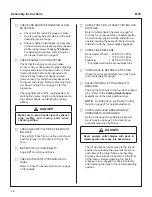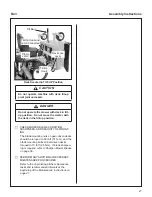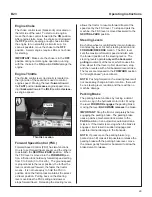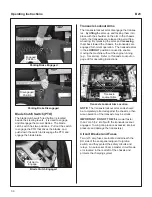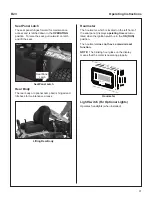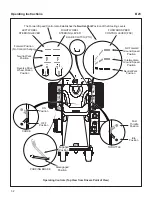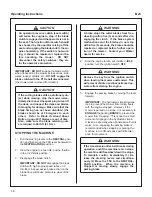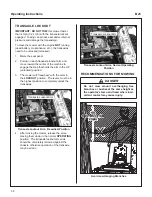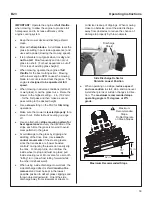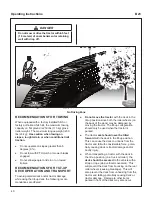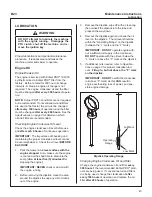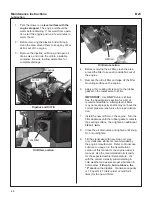
B23
Operating Instructions
29
Engine Choke
The choke control lever (black knob) is located on
the left side of the seat. To start a cold engine,
move the choke control forward to the
ON
position.
After engine starts, move the choke control toward
the
OFF
position, keeping enough choke to allow
the engine to run smoothly as it warms up. As
soon as possible, move the choke to the
OFF
position. A warm engine requires little or no choke
for starting.
IMPORTANT:
Make sure the choke is in the
OFF
position during normal engine operation; running
with the choke in the
ON
position
CAN
damage the
engine.
Engine Throttle
The throttle control lever (red knob) is located on
the right side of the seat and is used to control
engine speed. Moving the lever
forward
toward
the
FAST
position
increases
engine speed; mov-
ing it
backward
toward the
IDLE
position
decreas-
es
engine speed.
Throttle
Throttle Location
Forward Speed Control (FSC)
Forward Speed Control (FSC) has two functions:
One is to set forward travel speed, and the other is
to establish the
NEUTRAL-PARK
position. When
the FSC lever is moved into the
FORWARD
posi
-
tion, a friction lock holds any forward speed setting
from 0 to 8 mph (0 to 13 km/h). The ground speed
is proportional to the lever position; the further the
lever is advanced forward, the faster the tractor
moves. It is not necessary to hold the FSC in
position since the friction lock maintains the select-
ed lever position. Pulling back on the steering
levers overrides the FSC setting and slows or
stops forward travel. Releasing the steering levers
allows the tractor to resume forward travel at the
speed set by the FSC lever. To stop and park the
machine, the FSC lever is moved backward to the
NEUTRAL-PARK
position.
Steering Levers
Each drive wheel is controlled by its own indepen-
dent steering lever, for both steering function and
FORWARD/REVERSE
motion. The FSC lever
sets the maximum forward speed, and also sets
the forward position of the steering levers. The
steering levers operate
only with a backward
pulling
movement of the lever, which causes the
drive wheel for that lever to first slow down, stop,
and then reverse with a full backward lever stroke.
The levers are released to the
FORWARD
position
for “straight-ahead” ground travel.
NOTE:
Pushing forward on the steering levers will
not cause
any
change in tractor motion - there will
be no steering lever reaction and there will be no
machine damage.
Parking Brake
The parking brake functions by locking a detent
arm to a cog in the hydraulic motor rotor. Moving
the lever
FORWARD engages
the parking brake;
moving the lever
BACKWARD releases
the brake.
IMPORTANT:
Stop the tractor completely before
engaging the parking brake. The parking brake
uses a positive mechanical lock similar to the
PARK
position on an automotive automatic trans-
mission. If the tractor is moving when the brake is
engaged, it will result in sudden stoppage and
possible internal damage to the transaxle.
NOTE:
If pressure on the parking brake (e.g.,
parked on a hill) makes it impossible to release the
parking brake with the parking brake lever, move
the mower gently forward or backward to allow the
brake detent to release.


